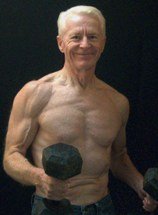Hi

A Letter
to Seniors
Years ago, I decided to write about fitness for older adults. But first I had to decide at what age to call my readers “seniors.” I took a tip from AARP and AMAC, the seniors’ advocacy companies that seem to know when anyone, anywhere, turns 50.
So I followed their lead. People age 50 and above would be my core audience, even though age 50 seemed to be early in life to be considered a senior.
Still, a gradual decline in physical ability does begin even earlier than 50. On average, its starts at somewhere around age 35. Even though most people who take care of themselves are able to perform well into their 40s.At about age 50, however, consideration to more age-appropriate physical efforts should be given. Certain kinds of workouts or competitions, in fact, may do us more harm than good. Particularly, excessive stress on tendons, ligaments, and joints may result in chronic aches and pains that take the fun out of life.
As I got older I noticed that I
didn't recover as quickly after hard workouts. I also experienced some shoulder pain I never had before. Through trial and error, I found that bench pressing made my shoulders sore. I replaced the movement with a variety of push-ups, and the pain went away.
(The bench press, by the way, is notorious. I have known guys — it’s usually men — who stubbornly try to push through chronic rotator cuff pain, and eventually are unable to do any exercise involving their shoulders. Sometimes surgery corrects this, but not always.)
Years ago, I did some long-distance running. I was just a middle-of-the-pack plodder. Today, I sometimes go to watch young family members run in long-distance races. At the finish lines I invariably see a few very senior runners, and admire their determination. But to tell you the truth, some look unhealthy. I think to myself that they’d be better off running shorter distances and putting more effort into muscle building and strength
training.
Dedicated martial artists provide other examples. Many who love the discipline, but continue to practice so-called “hard” styles into middle-age, and beyond, are often rewarded with chronic back and joint problems. Continuing training but changing to softer, or so-called "internal" styles, might be better choices as they get older.
The late, great Steve Reeves' competition full-body workouts lasted from two to three hours of heavy lifting and intensity. Still today, many seniors write and ask about how he trained. I refer them to a training site but remind them that his were competition workouts, and he was in his 20s. By the time he reached his 70s, he was doing mostly two sets per exercise and working with cables and a Universal machine, not heavy free weights, nor with the intensity of his youth. He never stopped training, but he knew enough to adjust and scale down.
Bob Hoffman, who
owned the York Barbell Company and years ago published Strength & Health magazine would tell readers: “Train. Don’t strain.” It was good advice then and it’s still good advice today.
Never stop training, but do adjust and make it age-appropriate. Remember that your mission is to stay as fit as possible for as long as possible. Beating yourself up isn't the way to do it.
Stay Healthy. Stay Fit.
Logan
Senior Exercise Central
Spread the word. If you like the newsletter, please forward it to a senior friend or acquaintance.
Photographs: Subscribers have asked when the newsletter photo at the top of the page and my website pictures were taken. Well, I was a mere 70 years old then. I’m 88 now. Though I remain active, I am no longer nearly as strong or muscular as I was 18 years ago. —LF
Are you on Facebook?
Check out the Senior Exercise Central page at . . .
https://www.facebook.com/GrayIronFitness
I search the Internet for senior health and fitness items. If you like what you see, please click the Like button. It helps me.
Newsletter Policy
The Gray Iron Fitness Newsletter is a free publication sent twice monthly to subscribers. The purpose is to provide honest and realistic fitness information for people age 50 and above.
I have never been paid or received compensation of any kind to write a positive review or endorse a product. If I say that I personally use a product or service, it is because I find value in it and have paid for it with my own money.
Like newspapers, magazines, and television, this newsletter and my website contain advertising and marketing links. Naturally, I am compensated for these.
The newsletter and website provide information to help users establish and maintain a fitness lifestyle. But fitness information is not the same as fitness advice, which is the application of exercise and dietary practices to an individual's specific circumstances. Therefore, always consult with your physician for assurance that fitness information, and
your interpretation of it, is appropriate for you.Your comments and questions are always appreciated. Simply click on the "Reply" bottom.
Sincerely,
Logan Franklin
The Gray Iron Fitness Newsletter
www.senior-exercise-central.com



